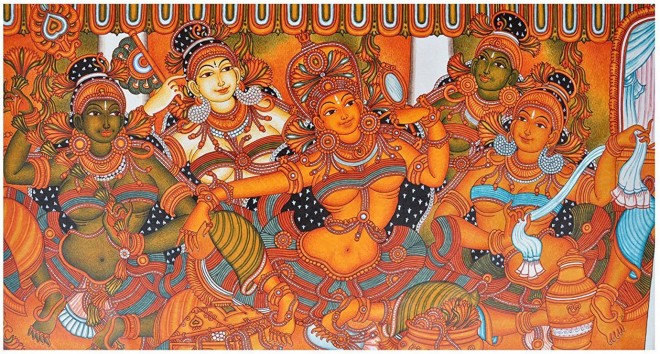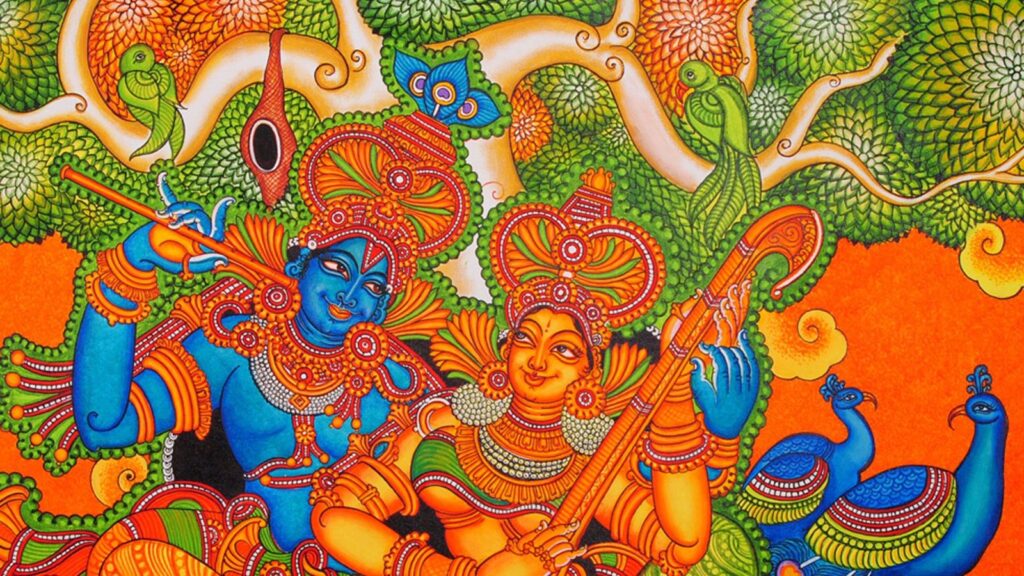Mural painting is a remarkable example of human creativity and expression in visual art. These large canvases are colourful affirmations of culture, history, and imagination that cover walls, buildings, and public areas. Every paint stroke conveys a narrative, every colour selection arouses feelings, and every image enthrals the viewer and transports them to a realm of wonder and reflection.
Murals have been an ever-present form of artistic expression, spanning time and space to leave a lasting impression on our collective psyche, from ancient civilizations to contemporary metropolises. Murals are a potent means of communication found on the walls of ancient temples, on the facades of modern metropolitan landscapes, or epic tales of bravery and mythology. They can convey messages, ignite conversations, and build community.
Murals frequently feature characters, settings, or symbols important to the local culture. They can celebrate and preserve a place’s culture by acting as visual depictions of historical events, folklore, and customs. Murals are frequently made in public areas instead of paintings seen in galleries or museums, making art more approachable to a broader audience. They provide artists with a platform for public expression, enabling them to share ideas, spark debate, or elicit strong feelings from the audience.
Murals are frequently the result of cooperation between local communities and artists. The mural may be planned, designed, or completed by community people, encouraging a sense of pride in the piece of art and the area it occupies. Murals can serve as a forum for social and political commentary on human rights, environmental preservation, and social justice issues. They give artists a potent platform to spread knowledge, encourage conversation, and motivate social change.

Murals are a great way to capture moments in time and preserve them for future generations. They can act as visual records of important historical events or periods. They contribute to deepening our understanding of history by providing insights into the concerns, values, and cultures of the past. Murals enhance urban settings’ aesthetic appeal, liveliness, and cultural and historical relevance. They breathe new life into public areas and establish a feeling of place by transforming bare walls into vibrant, captivating canvases.
History of mural painting
Drawing’s evolution has always been linked to the expansion of human society. Language systems and historical human survival strategies influenced drawing techniques, including farming, hunting, and trapping. Those areas’ items, narratives, and storytelling demonstrated these effects. Drawing arts were mainly used during these times to report (in the form of a shape) for rewinding aims. Drawing and painting were commonplace in their prehistoric activities. Eventually, alphabets arose as a writing system built by communication through photos and graphics, which were then standardised and controlled. Murus, a Latin term that originates from the wall, is where the word “mural” originates. A mural is a large-scale drawing painted on an outdoor or interior wall by a modern dictionary.
Among the most well-known works of art from the classical era are murals, which the Egyptians also utilised for their tombs, as did the Minos (castles), the Etruria (funeral arts), the Ancient Greeks (temples, houses), and the Old Romans (public institutions, dwellings). However, the Roman mural painters who created the classic murals found in Pompei were far more than just interior designers. Christians were also familiar with murals, especially those outside Rome’s cemeteries.
Indian mural painting has a long and rich history, from the second century BCE to the eighth and tenth centuries CE. These paintings, which exhibit a variety of methods, are found in over 20 locations around India, mainly in rock-cut chambers and natural caves. These paintings have been found all over the country; among the most famous sites include the Kailasanatha Temple in Ellora, Ajanta, Armamalai Cave, Ravan Chhaya Rock Shelter, Bagh Caverns, and Sittanavasal Caves. The appearance of these murals in naturally occurring caves and rock-cut chambers attests to their grace and beauty.
Kerala Mural Painting
Kerala, a state in southern India, is where the ancient art form known as Kerala Mural Painting first emerged. It is well known for its elaborate patterns, vivid colours, and representation of mythology and folklore. Kerala mural painting has a long and illustrious heritage that extends to the millennia. Its origins are in the Dravidian art style, and it takes inspiration from several sources, including Puranic, Mahabharata, and Ramayana religious writings.
Hindu gods and goddesses, as well as situations from Indian epics and mythology, are frequently depicted in the paintings. Deities such as Lord Krishna, Lord Shiva, Goddess Saraswati, and tales from the Ramayana and Mahabharata are common motifs. Paintings have unique colours because artists usually utilise natural pigments from minerals, plants, and even valuable stones. Natural binders such as lime water or tree sap are used with these pigments. Usually, on the walls of temples, palaces, and other hallowed places, the paintings are completed on surfaces that have been specifically prepared.
Kerala Mural Paintings are distinguished by their detailed detailing, bold contours, and two-dimensional, flat form. The stylized figures frequently include dynamic poses and have extended eyes and fingers. Every component of the painting has a symbolic meaning that relates to more profound spiritual and philosophical ideas. Additionally, the hues used have symbolic meanings; for example, red denotes strength and vitality, and green represents fertility.
Kerala mural painting has a rich history but has become less popular today. Nevertheless, attempts have been made to maintain and revitalise this art form. Training new painters and raising awareness of Kerala Mural Painting have been greatly aided by institutions and organisations committed to preserving indigenous art forms.
Krishna Mural Painting
In the larger category of Indian mural art, Krishna Mural Paintings are a popular theme, especially in areas like Kerala, Tamil Nadu, and Rajasthan, where worshipping Lord Krishna is deeply ingrained in culture and religion. Lord Krishna, one of Hindu mythology’s most adored and respected characters, is usually portrayed in these paintings. Krishna is frequently shown in a variety of iconic positions and moments from his life, like playing the flute (a well-known painting depicts Krishna playing the flute), dancing the Raas Leela (a kind of Hindu dance), carrying Govardhan hill, or playing with toys when he was younger.

The paintings frequently depict events from Krishna’s life as they are told in Hindu texts such as the Bhagavata Purana, the Mahabharata, and the Bhagavad Gita. These tales detail his early misadventures, his function as Arjuna’s charioteer and advisor during the Mahabharata conflict, and his lessons on dedication and dharma. Krishna Mural paintings have many styles, depending on the place and tradition they are from. Nonetheless, typical characteristics include vivid colours, fine craftsmanship, and a fusion of stylized and realistic elements. Artists use age-old methods like fresco, which involves using natural dyes and binders to apply pigments to freshly laid plaster or wood panels.
Radha Krishna Mural Painting
A subgenre of Indian art known as Radha Krishna Mural Paintings focuses on illustrating the heavenly love between Lord Krishna and his eternal consort, Radha. Radha Krishna mural paintings capture the essence of the holy love between Radha, Lord Krishna’s beloved follower and the highest divinity in Hinduism. Their relationship is praised as the pinnacle of fidelity, altruism, and spiritual unity. Numerous romantic and mythological moments from Radha and Krishna’s lives are frequently portrayed in the paintings. Scenes of them dancing the Raas Leela (divine dance), playing the flute together, sharing passionate looks, or having fun in the idyllic surroundings of Vrindavan could be among them.

Vivid colours, minute details, and expressive facial expressions distinguish Radha Krishna Mural Paintings. Artists frequently use rich blues, greens, and red colours to portray the intensity of Radha and Krishna’s love. Typically, the backgrounds depict verdant terrain, blossoming flowers, and meandering rivers, signifying the picturesque surroundings of Vrindavan. Every component in the painting has a meaningful meaning. A typical depiction of Radha is her wearing a crimson sari, signifying passion and love, whereas Krishna is seen with peacock feathers, symbolising his affinity for the natural world. The divine couple, representing celestial harmony and joy, is commonly shown flanked by Gopis (cowherd maidens) or playing musical instruments like the flute.
Kathakali Mural Painting
Traditional Kathakali mural paintings use vivid mural painting techniques to portray the famous dance-drama of Kathakali. It tells tales from Hindu mythology, especially those found in the epics of the Ramayana and Mahabharata, using dance, music, theatre, and lavish costumes. Kathakali mural paintings depict the characters’ ornate costumes, dexterous makeup, expressive facial expressions, and dynamic positions, thereby encapsulating the essence of Kathakali performances. On a two-dimensional surface, artists adeptly replicate the dramatic intensity and emotive power of Kathakali.
Scenes from well-known Kathakali plays, including “Nalacharitham,” “Kalyanasougandhikam,” “Keechaka Vadham,” and “Duryodhana Vadham,” are frequently depicted in the paintings. These myths and Hindu epics are the source of these stories, which usually centre on themes of courage, morality, love, and devotion. Kathakali Mural Paintings have vivid colours, minute details, and stylised character depictions. The “abhinaya,” or Kathakali artists, are famed for their expressive facial expressions (Rasas) and hand gestures (mudras), which are frequently highlighted in the paintings to portray the story’s emotions and plot.
A mural painting is a striking example of human ingenuity, culture, and expression. This art style has endured and changed over time. Civilizations have changed from prehistoric cave paintings to contemporary urban murals, which have had a lasting impression on human history. Artists have used mural painting to explore various themes, from historical events and religious devotion to social commentary and political activity. These enormous pieces of art have a quality that makes them transcend boundaries; they appeal to individuals of all backgrounds and tell the story of our common humanity in pictures.
Saved or Sold: Diego Rivera’s Mural Stuck at the San Francisco Art Institute





